Assessing Solutions for Resilient Dairy Farming in Europe
Simple Summary
Abstract
1. Introduction
2. Materials and Methods
2.1. Workflow
2.2. Assessment of Experts’ Input
2.3. Assessment of NDA Workshops’ Input
3. Results
3.1. Experts’ Assessments of Individual Solutions
3.2. Experts’ Assessments of Categories of Solutions
3.3. National Dairy AKIS Groups Evaluating Solutions
4. Discussion
5. Concluding Remarks
Author Contributions
Funding
Institutional Review Board Statement
Informed Consent Statement
Data Availability Statement
Acknowledgments
Conflicts of Interest
References
- European Parliament. Research for AGRI Committee—Development of Milk Production in the EU after the End of Milk Quotas; European Parliament, Policy Department for Structural and Cohesion Policies: Brussels, Belgium, 2023; Available online: https://european-union.europa.eu/index_en (accessed on 1 August 2024).
- Kuipers, A.; Malak-Rawlikowska, A.; Stalgiene, A.; Klopčič, M. Analysis of Stakeholders’ Expectations for Dairy Sector Development Strategies from a Central-Eastern and Western European Perspective. Ger. J. Agric. Econ. 2017, 66, 265. [Google Scholar] [CrossRef]
- European Parliament. The EU Dairy Sector—Main Features, Challenges and Prospects. The EU Dairy Sector; European Parliament, Policy Department for Structural and Cohesion Policies: Brussels, Belgium, 2024; Available online: https://european-union.europa.eu/index_en (accessed on 1 August 2024).
- Loges, R.; Bunne, I.; Reinsch, T.; Malisch, C.S.; Kluß, C.; Herrmann, A.; Taube, F. Forage production in rotational systems generates similar yields compared to maize monocultures but improves soil carbon stocks. Eur. J. Agron. 2018, 97, 11–19. [Google Scholar] [CrossRef]
- Chen, l.; Thorup, V.M.; Kudahl, A.B.; Østergaard, S. Effects of heat stress on feed intake, milk yield, milk composition, and feed efficiency in dairy cows: A meta-analysis. J. Dairy Sci. 2023, 107, 3207–3218. [Google Scholar] [CrossRef] [PubMed]
- Thorsøe, M.; Noe, E.; Maye, D.; Vigani, M.; Kirwan, J.; Chiswell, H.; Grivins, M.; Adamsone-Fiskovica, A.; Tisenkopfs, T.; Tsakalou, E.; et al. Responding to change: Farming system resilience in a liberalized and volatile European dairy market. Land Use Policy 2020, 99, 105029. [Google Scholar] [CrossRef]
- Kuipers, A.; Malak-Rawlikowska, A.; Stalgiene, A.; Ule, A.; Klopcic, M. European Dairy Farmers’ Perceptions and Responses towards Development Strategies in Years of Turbulent Market and Policy Changes. Agriculture 2021, 11, 293. [Google Scholar] [CrossRef]
- Gorton, M.; Douarin, E.; Davidova, S.; Latruffe, L. Attitudes to agricultural policy and farming futures in the context of the 2003 CAP reform: A comparison of farmers in selected established and new member states. J. Rural Stud. 2008, 24, 322–336. [Google Scholar] [CrossRef]
- Kuipers, A.; Rozstalnyy, A.; Keane, G. (Eds.) Cattle Husbandry in Eastern Europe and China: Structures, Development Paths and Optimization; EAAP Scientific Publ. 135; Wageningen Academic Publishers: Wageningen, The Netherlands, 2014. [Google Scholar] [CrossRef]
- Brocard, V.; Belot, P.-E.; Foray, S.; Perrot, C.; Rouillé, B. High output farming systems in Europe: The French case. Grassl. Sci. 2015, 20, 26–39. [Google Scholar]
- Dairy Australia. Horizon 2020 Project—Future Scenarios for the Australian Dairy Industry. Dairy Australia and the Geoffrey Gardiner Dairy Foundation. 2013. Available online: https://www.dairyaustralia.com.au/ (accessed on 1 August 2024).
- Dooley, A.E.; Dhananjay Apparao, M.; Mc Carthy, I.A.; Parminter, T.; Shadbolt, N.M. Envisaging future New Zealand dairy farm systems: A scenario analysis approach. Int. J. Agric. Manag. 2018, 7, 41–49. [Google Scholar]
- Britt, J.H.; Cushman, R.H.; Dechow, C.D.; Dobson, H.; Humblot, P.; Hutjens, M.F.; Jones, G.A.; Ruegg, P.S.; Sheldon, I.M.; Stevenson, J.S. Invited review: Learning from the future—A vision for dairy farms and cows in 2067. J. Dairy Sci. 2017, 101, 3722–3741. [Google Scholar] [CrossRef] [PubMed]
- Malak-Rawlikowska, A.; Kuipers, A.; Stalgiene, A.; Smit, B.; Kristof, P.; Schaer, B.; Klopčič, M. Farming with Vision—Strategy, Networking, Marketing, and Business Planning; Publisher of University of Life Sciences: Warsaw, Poland, 2018; Available online: http://ism.sggw.pl/wp-content/uploads/2019/01/ISM-END.pdf (accessed on 1 August 2024).
- Ruska, D.; Naglis-Liepa, K. Effect of mitigation measures on GHG and ammonia emissions of pilot farms in European countries. In Proceedings of the EAAP-74th Annual Meeting (2023): Climate Change, Biodiversity and Global Sustainability of Animal Production (Abstract EAAP 2023), Lyon, France, 28 August 2023. [Google Scholar]
- Darnhofer, I. Strategies of family farms to strengthen their resilience. Environ. Policy Gov. 2010, 20, 212. [Google Scholar] [CrossRef]
- Meuwissen, M.P.M.; Feindt, P.H.; Slijper, T.; Spiegel, A.; Finger, R.; de Mey, Y.; Paas, W.; Termeer, K.; Poortvliet, M.; Peneva, M.; et al. A framework to assess the resilience of farming systems. Agric. Syst. 2019, 176, 102656. [Google Scholar] [CrossRef]
- Quinlan, A.E.; Berbés-Blázquez, M.; Haider, L.J.; Peterson, G.D. Measuring and assessing resilience: Broadening understanding through multiple disciplinary perspectives. J. Appl. Ecol. 2016, 53, 677–687. [Google Scholar] [CrossRef]
- Van Dixhoorn, I. Disease Resilience in Farm Animals. Ph.D. Thesis, Wageningen University, Wageningen, The Netherlands, 2024. [Google Scholar] [CrossRef]
- EU-Project Resilience for Dairy (R4D) during 2021–2024. Available online: https://resilience4dairy.eu (accessed on 1 August 2024).
- Kołoszycz, E.; Wilczynski, A.; Menghi, A.; Soffiantini, C.S.; Klopcic, M. Searching for Dairy Farm Resilience with the R4D Project: Innovation Needs to Be Sustainable. Sustainability 2024, 16, 3520. [Google Scholar] [CrossRef]
- Soubry, B.; Sherren, K. “You keep using that word…”: Disjointed definitions of resilience in food systems adaptation. Land Use Policy 2021, 114, 105954. [Google Scholar] [CrossRef]
- Urruty, N.; Tailliez-Lefebvre, D.; Huyghe, C. Stability, robustness, vulnerability and resilience of agricultural systems, A review. Agron. Sustain. Dev. 2016, 36, 15. [Google Scholar] [CrossRef]
- Banzhaf, E.; Anderson, S.; Grandin, G.; Hardiman, R.; Jensen, A.; Jones, L.; Knopp, J.; Levin, G.; Russel, D.; Wu, W.; et al. Dependencies and Opportunities to Design Nature-Based Solutions for Resilience in Europe and China. Land 2022, 11, 480. [Google Scholar] [CrossRef]
- Cranley, A.; Cummings, G.G.; Profetto-McGrath, J.; Toth, F.; Estabrooks, C.A. Facilitation roles and characteristics associated with research use by healthcare professionals: A scoping revie. BMJ Open 2017, 7, 014384. [Google Scholar] [CrossRef] [PubMed]
- Klopčič, M.; Kuipers, A.; Malak-Rawlikowska, A.; Stalgiene, A.; Ule, A.; Erjavec, K. Dairy farmers’ strategies in four European countries before and after abolition of the milk quota. Land Use Policy 2019, 88, 104169. [Google Scholar] [CrossRef]
- Erjavec, K.; Klopčič, M. Attitudes of consumers, farmers and stakeholders towards innovative dairy cattle housing systems. Animals 2022, 12, 1231. [Google Scholar] [CrossRef] [PubMed]
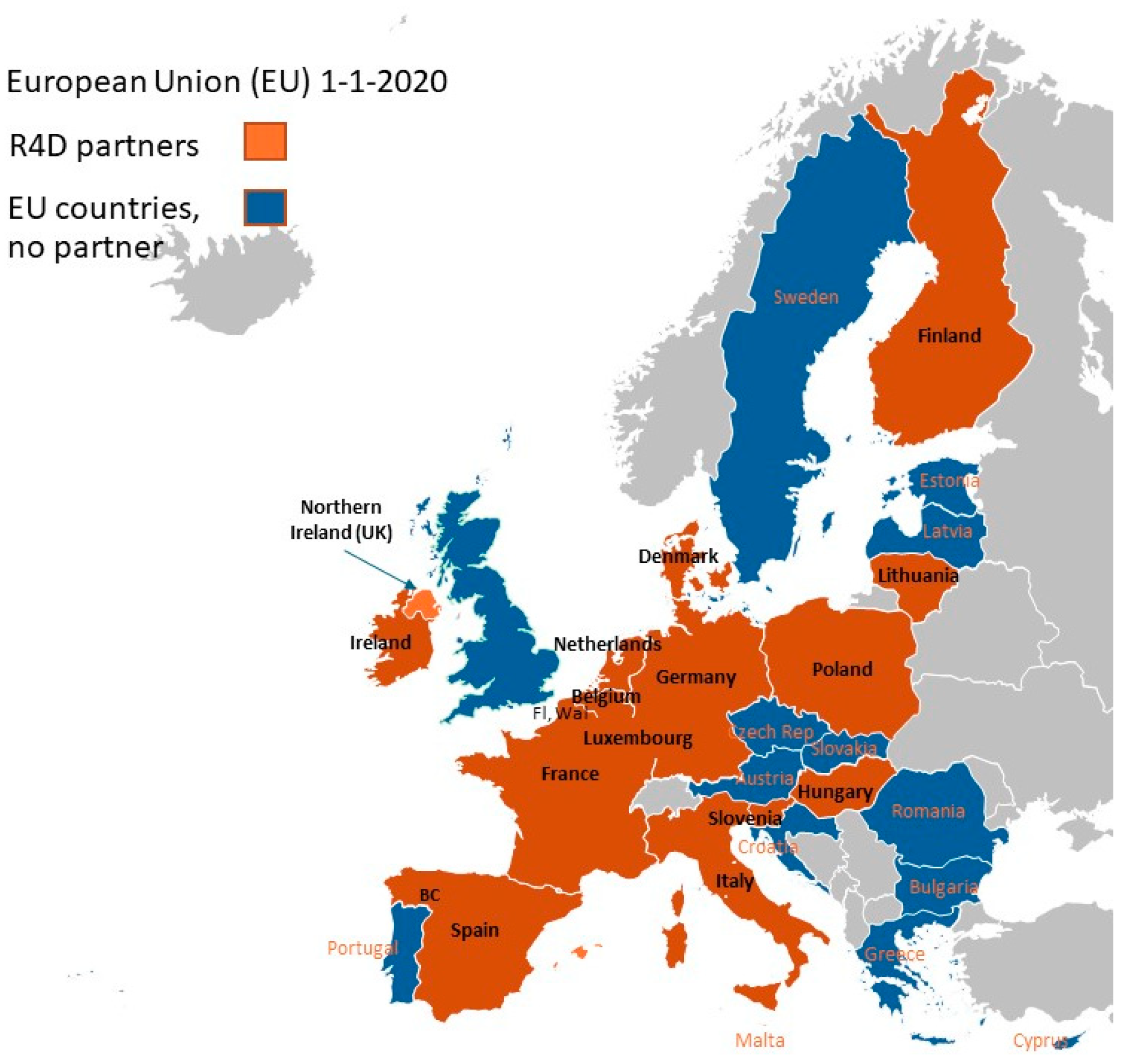
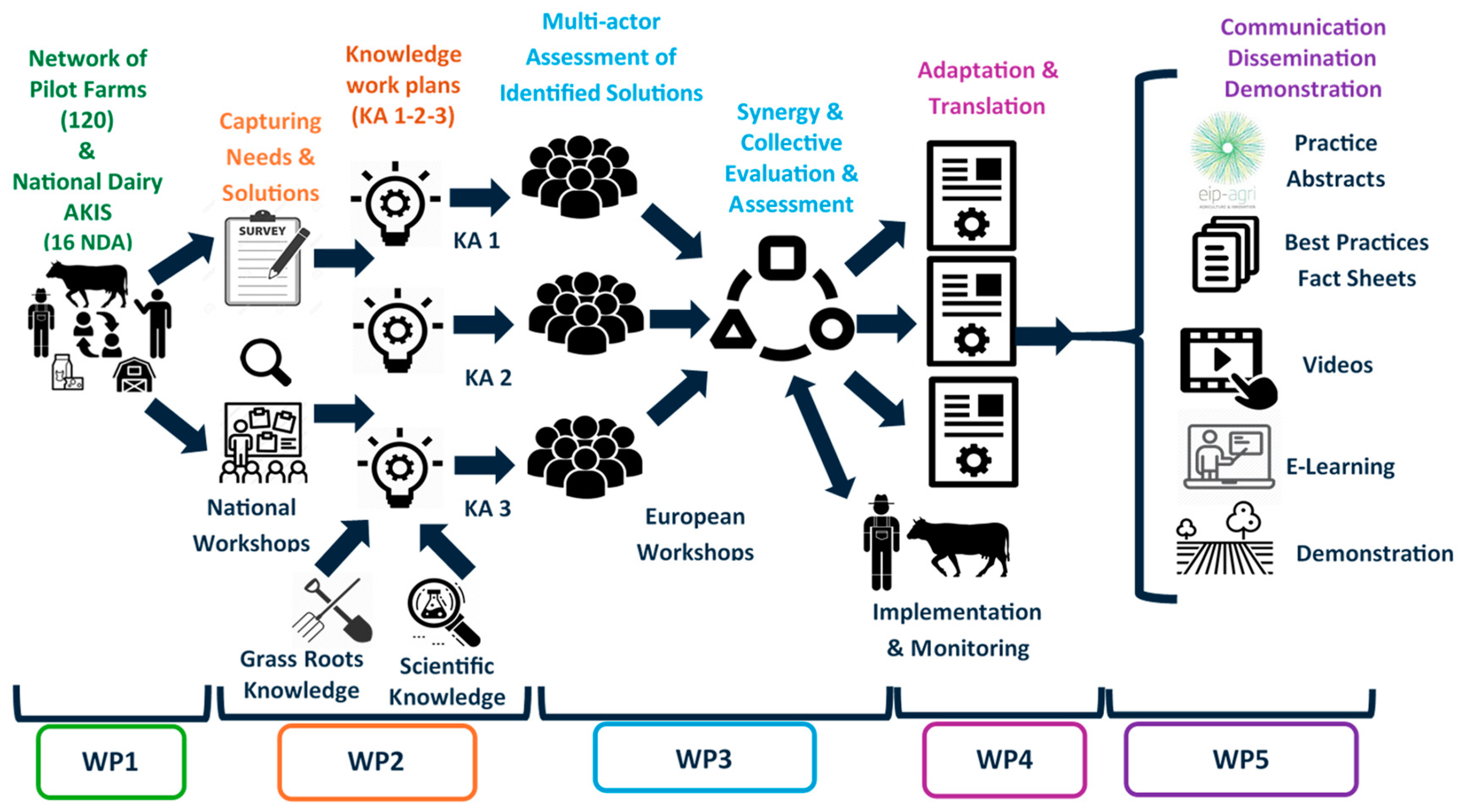
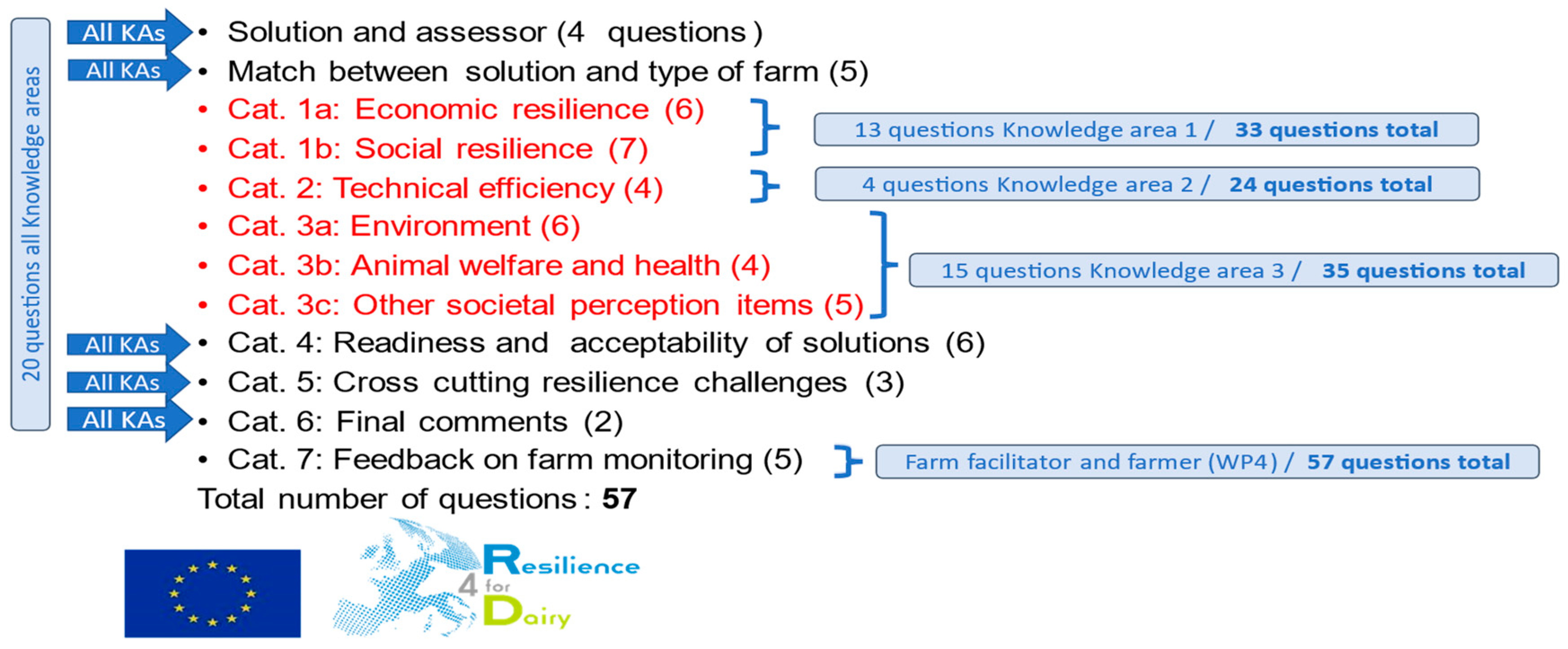
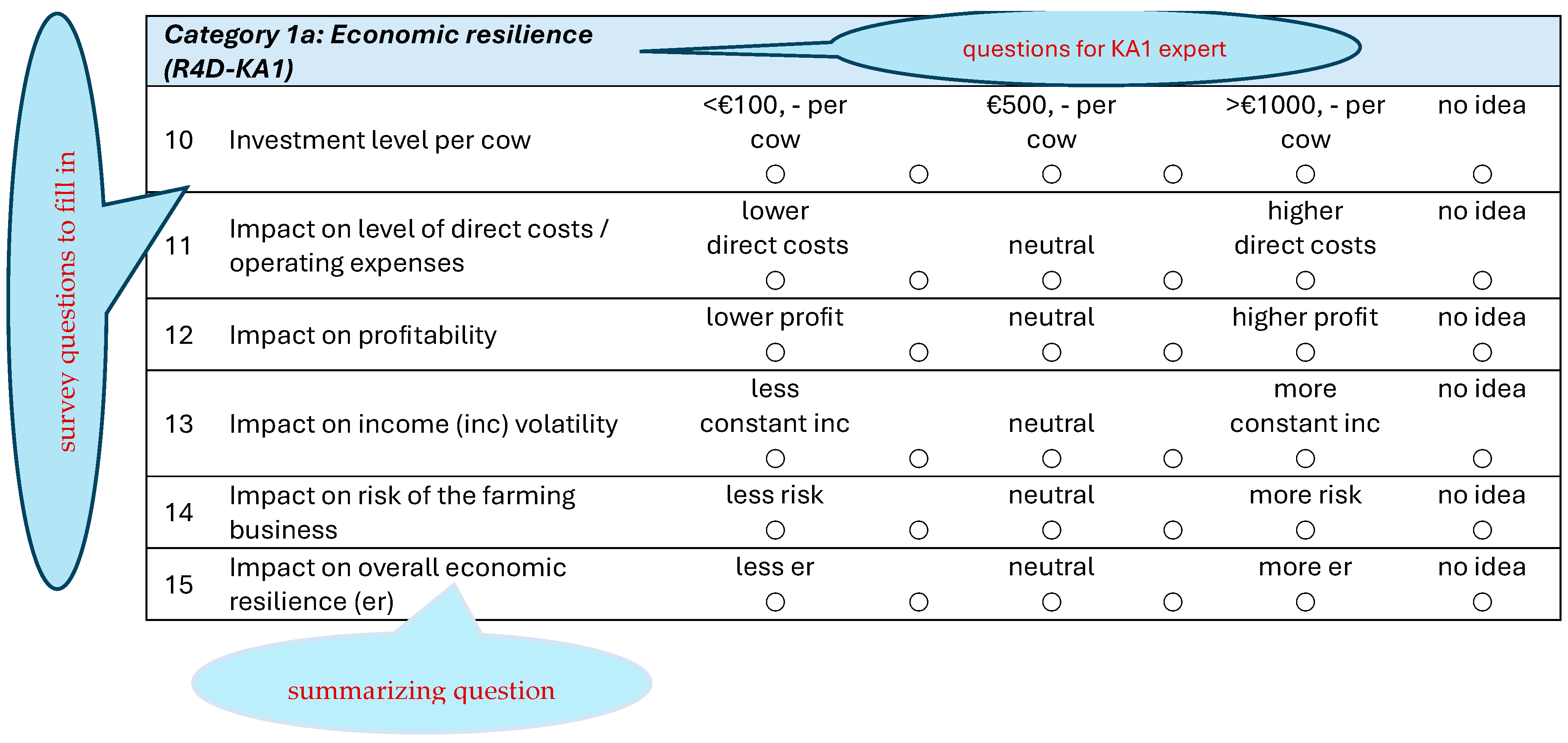

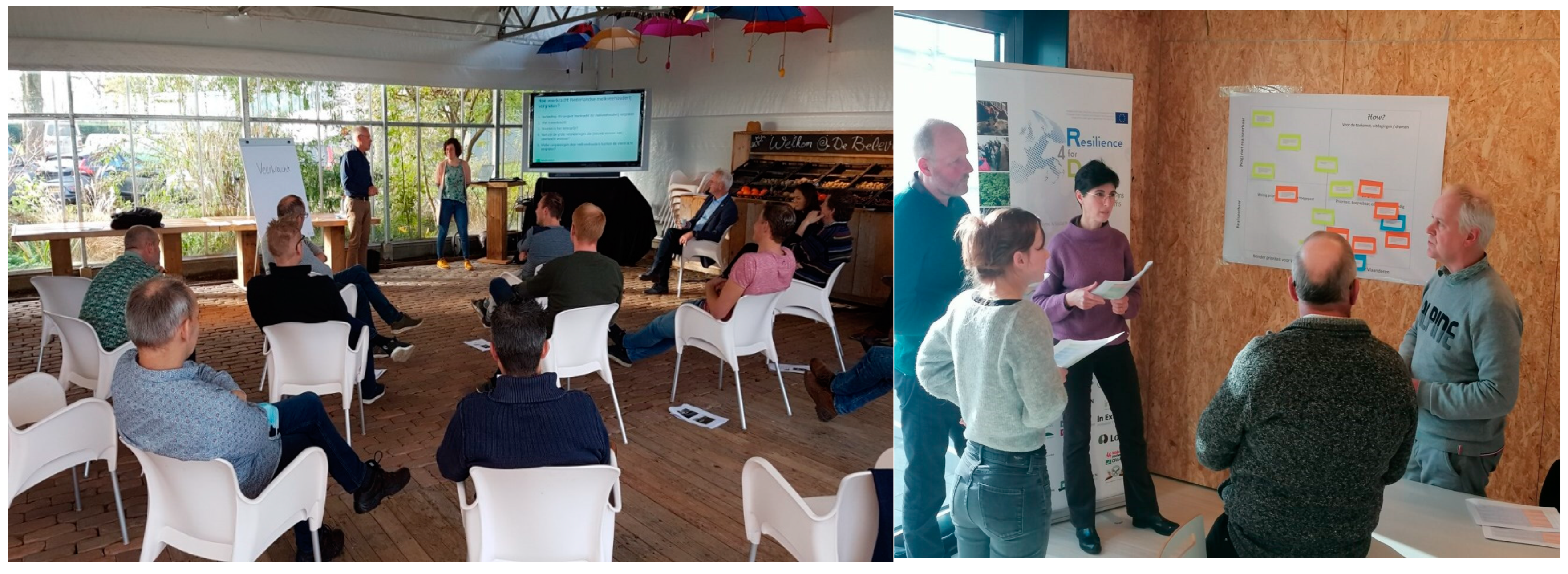
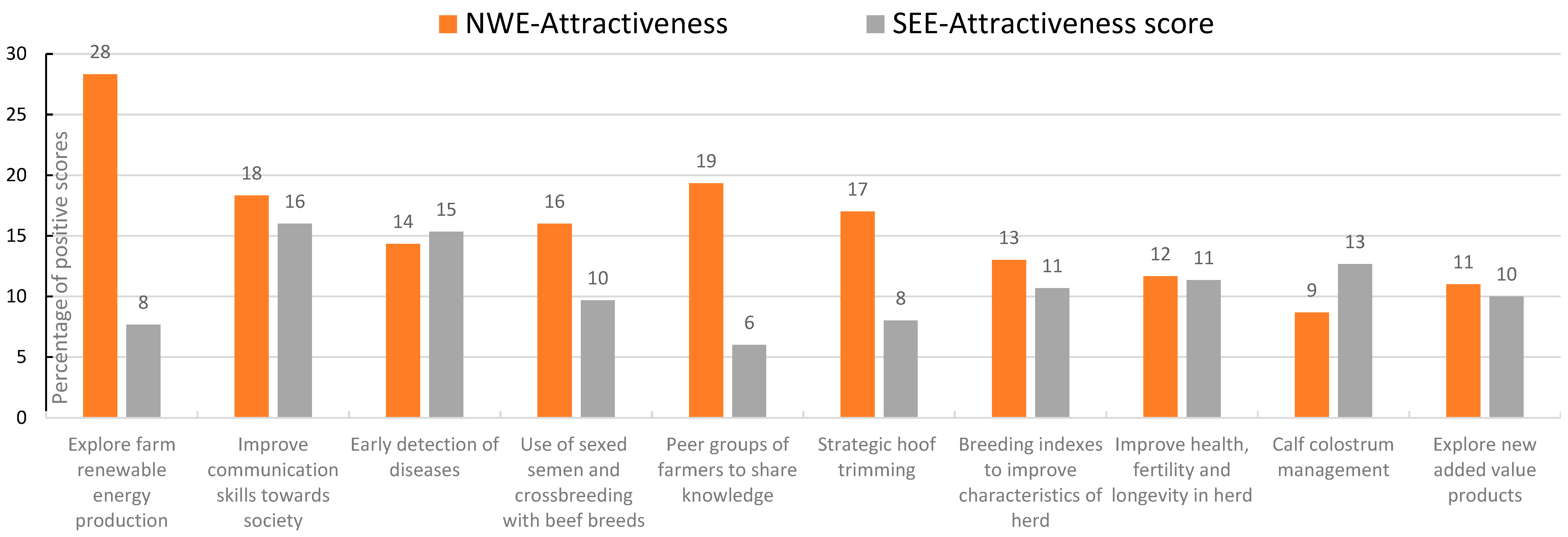
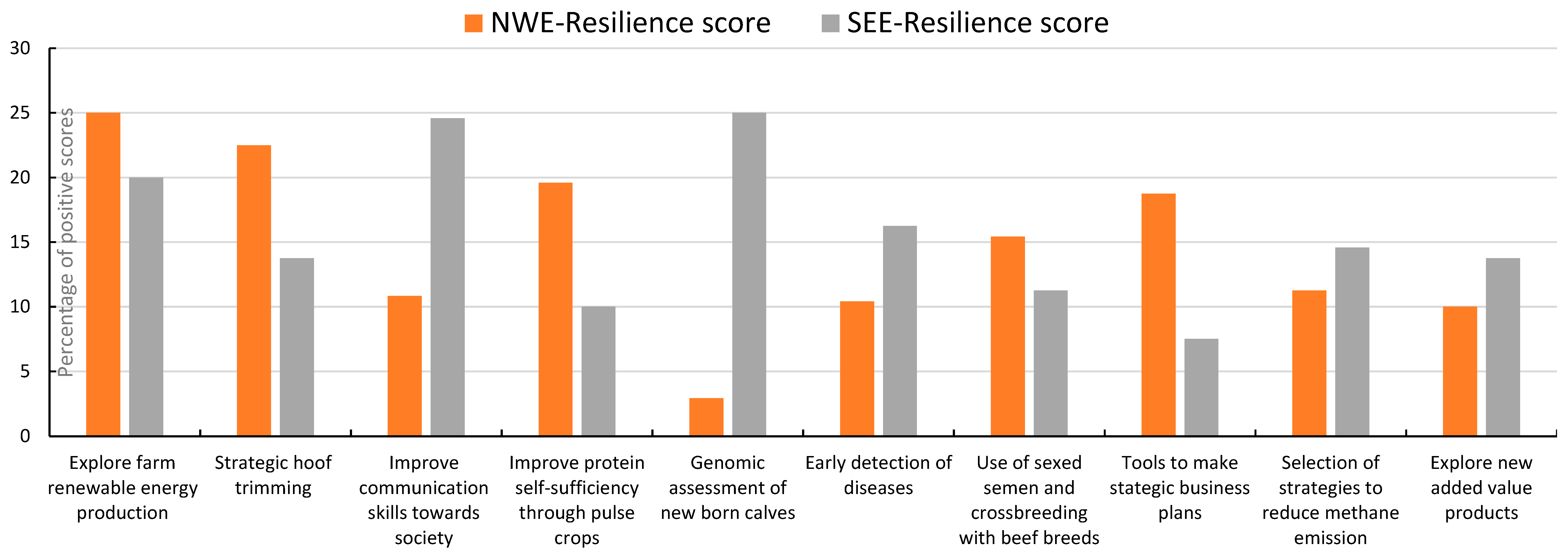

| Title of Solution | Knowledge Area/Impact Field | |||||
|---|---|---|---|---|---|---|
| Economic Resilience | Social Resilience | Economic + Social Resilience | ||||
| Mean | SD | Mean | SD | Mean | SD | |
| Lean management | 4.17 | 0.48 | 3.70 | 0.57 | 3.94 | 0.41 |
| Reparceling of land | 3.86 | 0.31 | 4.03 | 0.41 | 3.95 | 0.29 |
| Manage cash flows, investment, and risks to increase mental health and resilience of farmer | 4.12 | 0.30 | 3.50 | 0.67 | 3.81 | 0.42 |
| Improve quality consultancy services, engage advisory in farm management | 3.84 | 0.48 | 3.50 | 0.60 | 3.65 | 0.50 |
| Tools to make business plans to support strategic decisions | 3.76 | 0.53 | 3.53 | 0.51 | 3.64 | 0.39 |
| Peer groups of farmers to share knowledge using facilitation methods | 3.78 | 0.43 | 3.46 | 0.42 | 3.62 | 0.34 |
| On-farm dairy heifer valorization | 3.43 | 0.59 | 2.50 | 0.49 | 2.96 | 0.51 |
| Exploring on farm milk-processing | 3.20 | 0.36 | 2.54 | 0.38 | 2.87 | 0.27 |
| Title of Solution | Knowledge Area/Impact Field | |
|---|---|---|
| Technical Efficiency | ||
| Mean | SD | |
| Strategic hoof trimming | 4.72 | 0.40 |
| Calf colostrum management | 4.46 | 0.60 |
| Sensors monitoring insight in health and fertility | 4.17 | 0.54 |
| Manure application tailored to needs plant | 4.13 | 0.82 |
| Early detection of diseases | 4.11 | 0.59 |
| Cross-breeding with beef cattle | 4.06 | 0.80 |
| Conservation tillage to reduce erosion | 3.36 | 1.01 |
| Combining efficient grazing with robotic milking | 3.13 | 0.74 |
| Title of Solution | Knowledge Area/Impact Field | |||||||
|---|---|---|---|---|---|---|---|---|
| Environment | Animal Welfare and Health | Societal Perception | Welfare and Health + Environment + Perception | |||||
| Mean | SD | Mean | SD | Mean | SD | Mean | SD | |
| Improvement of health, fertility and longevity in herds | 3.41 | 0.40 | 4.40 | 0.62 | 3.88 | 0.46 | 3.90 | 0.44 |
| Freewalk farming system | 3.68 | 0.56 | 4.26 | 0.51 | 3.54 | 0.46 | 3.84 | 0.41 |
| Agroforestry on dairy farms | 3.81 | 0.44 | 3.46 | 0.57 | 3.74 | 0.39 | 3.67 | 0.38 |
| Barns for more animal welfare with access to outside | 3.15 | 0.43 | 4.31 | 0.51 | 3.55 | 0.50 | 3.67 | 0.32 |
| Biodiversity implementation package for dairy farms | 3.94 | 0.41 | 3.38 | 0.55 | 3.43 | 0.50 | 3.60 | 0.27 |
| Apply sand as deep bedding in cubicles to improve health, welfare and productivity | 3.20 | 0.30 | 4.12 | 0.56 | 3.48 | 0.36 | 3.60 | 0.31 |
| Use solid part of slurry as bedding material in cubicles | 3.59 | 0.35 | 3.20 | 0.27 | 2.91 | 0.24 | 3.22 | 0.18 |
| Feed additives to reduce rumen methane production | 3.51 | 0.42 | 2.96 | 0.54 | 3.00 | 0.32 | 3.17 | 0.26 |
| Category of Solutions | No. of Solutions | No. of Assessments | Assessors from the Three Knowledge Areas’ Resilience Scores for Solutions Related to the Impact Field: | ||||||||||
|---|---|---|---|---|---|---|---|---|---|---|---|---|---|
| Economics | Social Life | Environment | Welfare and Health | Societal Perception | |||||||||
| Socio-Economics | NWE | SEE | NWE | SEE | NWE | SEE | NWE | SEE | NWE | SEE | NWE | SEE | |
| Business | 9 | 121 | 82 | 3.55 | 3.55 | 3.12 | 3.08 | 3.17 | 3.41 | 3.15 | 3.53 | 3.33 | 3.51 |
| Collaboration | 5 | 54 | 43 | 3.53 | 3.55 | 3.52 | 3.51 | 3.37 | 3.51 | 3.20 | 3.41 | 3.21 | 3.23 |
| Dairy policy | 4 | 36 | 35 | 3.55 | 3.85 | 3.31 | 3.14 | 3.16 | 3.20 | 3.31 | 3.45 | 3.32 | 3.20 |
| Education | 9 | 98 | 67 | 3.53 | 3.61 | 3.38 | 3.30 | 3.21 | 3.54 | 3.44 | 3.79 | 3.38 | 3.81 |
| Interest in farming | 5 | 45 | 40 | 3.68 | 3.69 | 3.45 | 3.24 | 3.05 | 3.46 | 3.15 | 3.33 | 3.24 | 3.46 |
| Labor efficiency | 4 | 46 | 30 | 3.58 | 3.85 | 3.56 | 3.32 | 3.23 | 3.53 | 3.32 | 3.69 | 3.21 | 3.40 |
| Social welfare | 8 | 76 | 55 | 3.37 | 3.56 | 3.64 | 3.74 | 3.08 | 3.29 | 3.09 | 3.37 | 3.11 | 3.18 |
| Added value products | 2 | 26 | 23 | 3.40 | 3.59 | 2.96 | 2.84 | 3.60 | 3.84 | 3.25 | 3.63 | 3.67 | 3.64 |
| Environment/anim. health and welfare | Technical efficiency | ||||||||||||
| Animal welfare | 12 | 145 | 108 | 3.33 | 3.98 | 3.11 | 3.30 | 4.07 | 4.07 | 3.47 | 3.43 | ||
| Biodiversity | 4 | 59 | 32 | 3.67 | 2.93 | 3.75 | 4.00 | 3.48 | 3.42 | 3.43 | 3.32 | ||
| Carbon footprint | 5 | 75 | 37 | 3.56 | 3.51 | 3.65 | 3.77 | 3.00 | 3.13 | 3.16 | 3.08 | ||
| Energy | 3 | 43 | 24 | 3.67 | 3.55 | 3.50 | 3.63 | 3.00 | 3.29 | 3.18 | 3.03 | ||
| Manure management | 9 | 71 | 54 | 3.27 | 3.88 | 3.65 | 3.83 | 3.04 | 3.15 | 3.10 | 3.14 | ||
| Emissions | 3 | 23 | 23 | 4.00 | 3.97 | 3.76 | 3.80 | 3.05 | 3.38 | 3.20 | 3.20 | ||
| Society | 2 | 22 | 24 | 3.50 | 3.98 | 3.00 | 3.20 | 3.00 | 3.29 | 3.61 | 3.48 | ||
| Water | 3 | 26 | 23 | 4.00 | 3.53 | 3.66 | 3.43 | 3.10 | 3.49 | 3.19 | 3.08 | ||
| Technical efficiency | |||||||||||||
| Automation | 1 | 15 | 17 | 3.50 | 3.87 | 3.08 | 3.60 | 3.44 | 4.17 | 3.18 | 3.25 | ||
| Breeding | 11 | 136 | 93 | 3.86 | 4.01 | 3.27 | 3.55 | 3.35 | 3.68 | 3.14 | 3.76 | ||
| Crops | 13 | 150 | 78 | 3.92 | 3.55 | 3.75 | 3.91 | 3.02 | 3.11 | 3.14 | 3.32 | ||
| Feeding | 22 | 221 | 118 | 3.54 | 3.84 | 3.28 | 3.54 | 3.20 | 3.64 | 3.09 | 3.57 | ||
| Grassland | 17 | 197 | 75 | 3.47 | 3.73 | 3.61 | 3.79 | 3.34 | 3.63 | 3.27 | 3.76 | ||
| Health | 23 | 265 | 120 | 3.93 | 4.05 | 3.13 | 3.40 | 3.81 | 3.94 | 3.40 | 3.99 | ||
| Herd management | 8 | 98 | 48 | 4.04 | 3.77 | 3.35 | 3.55 | 3.34 | 3.59 | 3.09 | 3.50 | ||
| Info and communication technology | 5 | 54 | 41 | 3.27 | 3.85 | 3.14 | 3.54 | 3.38 | 3.92 | 3.07 | 3.56 | ||
Disclaimer/Publisher’s Note: The statements, opinions and data contained in all publications are solely those of the individual author(s) and contributor(s) and not of MDPI and/or the editor(s). MDPI and/or the editor(s) disclaim responsibility for any injury to people or property resulting from any ideas, methods, instructions or products referred to in the content. |
© 2024 by the authors. Licensee MDPI, Basel, Switzerland. This article is an open access article distributed under the terms and conditions of the Creative Commons Attribution (CC BY) license (https://creativecommons.org/licenses/by/4.0/).
Share and Cite
Kuipers, A.; Østergaard, S.; Loges, R.; Zijlstra, J.; Brocard, V. Assessing Solutions for Resilient Dairy Farming in Europe. Animals 2024, 14, 2991. https://doi.org/10.3390/ani14202991
Kuipers A, Østergaard S, Loges R, Zijlstra J, Brocard V. Assessing Solutions for Resilient Dairy Farming in Europe. Animals. 2024; 14(20):2991. https://doi.org/10.3390/ani14202991
Chicago/Turabian StyleKuipers, Abele, Søren Østergaard, Ralf Loges, Jelle Zijlstra, and Valerie Brocard. 2024. "Assessing Solutions for Resilient Dairy Farming in Europe" Animals 14, no. 20: 2991. https://doi.org/10.3390/ani14202991
APA StyleKuipers, A., Østergaard, S., Loges, R., Zijlstra, J., & Brocard, V. (2024). Assessing Solutions for Resilient Dairy Farming in Europe. Animals, 14(20), 2991. https://doi.org/10.3390/ani14202991










